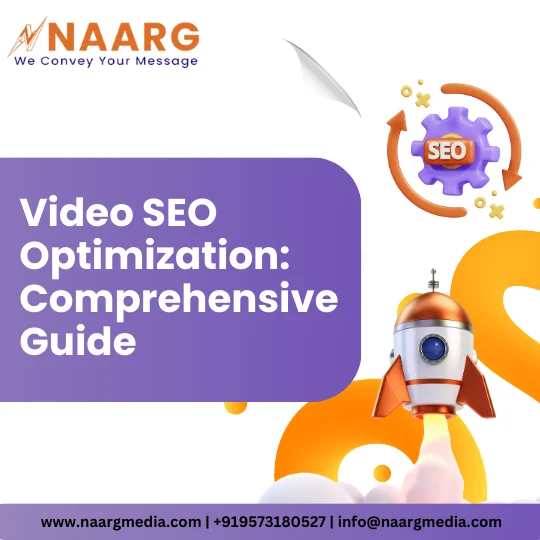Video content has become a cornerstone of online engagement. With billions of videos consumed daily across platforms like YouTube, TikTok, and Instagram, businesses and creators face a common challenge: ensuring their videos get noticed in a sea of content.
This is where video SEO optimization comes into play. Video SEO optimization isn’t just a buzzword; it’s a strategic approach to making your videos discoverable, relevant, and appealing to viewers and search engines.
From boosting your rankings on Google and YouTube to increasing watch time and click-through rates, the right optimization techniques can transform how your audience finds and interacts with your content.
In this blog, we’ll explore everything you need to know about video SEO optimization; you’ll learn tips to enhance your videos.
Get ready to maximize the visibility of your videos and drive unparalleled growth in your online presence!

What is Video SEO?
Video SEO, or Video Search Engine Optimization, is the process of optimizing your video content to improve its visibility and ranking on search engine results pages (SERPs) and video platforms like YouTube.
It involves the strategic use of keywords, metadata, tags, captions, and other elements to ensure your videos reach the right audience at the right time. With video content making up over 82% of all internet traffic, leveraging video SEO is no longer optional—it’s essential.
By optimizing your videos, you not only increase their discoverability but also enhance viewer engagement, driving more traffic and conversions for your brand.
Benefits of Optimizing Video Content for Search Engines
Optimizing your video content for search engines offers a multitude of benefits that can significantly enhance your digital presence and business outcomes.
Here are some key advantages:
1. Increased Visibility and Reach
When your videos are optimized for search engines, they are more likely to appear in relevant search results, whether on Google, YouTube, or other platforms. This leads to greater exposure, allowing you to reach a wider audience and attract more views.
Optimized videos have a higher chance of ranking in both search engines and video platform algorithms, giving your content a competitive edge.
2. Improved Engagement and Click-Through Rates
Search engines prioritize videos that keep users engaged. With better optimization, your videos will attract viewers who are more likely to watch them in their entirety, increasing metrics like watch time and engagement.
This not only improves your video ranking but also helps build a loyal audience.
3. Higher Conversion Rates
When optimized, your videos are more likely to target users who are already searching for solutions or products you offer. This improves the chances of converting views into leads, sales, or other desired actions.
Whether you are promoting a product, educating your audience, or building brand awareness, video SEO increases the likelihood of achieving your goals.
4. Better User Experience
Optimized videos ensure they load faster, have relevant captions, and provide meaningful descriptions—contributing to a better overall user experience.
This boosts your reputation with both users and search engines, as platforms reward high-quality, user-friendly content.
Key Ranking Factors for Video SEO
To ensure your videos rank higher in search results and attract more viewers, it’s essential to focus on several key ranking factors. These elements directly impact your video’s visibility and performance, both on video platforms like YouTube and in general search engine results.
Here are the most important factors to consider for video SEO:
1. Video Title
Your video title is one of the most critical ranking factors. It should be clear, descriptive, and contain relevant keywords that potential viewers might search for.
A well-crafted title will not only help with ranking but also grab the attention of users, encouraging them to click and watch your content.
2. Video Description
A detailed and informative video description plays a significant role in video SEO. Include your primary keywords naturally, and make sure to provide a comprehensive overview of what your video is about.
Descriptions help search engines understand the context of your video, improving its chances of ranking higher for relevant searches.
3. Tags
Tags help YouTube and other video platforms categorize your content and make it discoverable to users. Use a combination of broad and specific tags related to your video, ensuring they align with the topic and keywords.
Tags act as metadata, helping the algorithm match your video with the right audience.
4. Thumbnail
A custom thumbnail is a powerful visual tool for attracting clicks. Videos with eye-catching, high-quality thumbnails are more likely to stand out in search results, leading to higher click-through rates.
While thumbnails don’t directly influence SEO, they greatly affect user behavior and engagement, which in turn can improve rankings.
5. Engagement Metrics (Likes, Comments, Shares, and Watch Time)
Video platforms heavily weigh engagement metrics in their ranking algorithms. Higher levels of interaction, such as likes, comments, and shares, signal to search engines that your video is valuable.
Additionally, watch time (the amount of time viewers spend watching your video) is a key ranking factor, with longer watch times leading to better video visibility.
How to Optimize Video Content?
Optimizing video content is crucial for improving its discoverability, engagement, and overall performance across search engines and video platforms.
By following these steps, you can ensure your videos are reaching the right audience and getting the attention they deserve:
1. Start with a Keyword-Optimized Title
Your video title is one of the first things viewers see, and it plays a major role in how search engines rank your video. Make sure to incorporate your primary keyword in the title, and keep it clear, descriptive, and engaging.
A good title should reflect the content accurately while also sparking curiosity. For example, instead of a generic title like “Cooking Tips,” try something more specific like “5 Quick and Healthy Cooking Tips for Busy Professionals.”
2. Write a Detailed Video Description
The video description is another essential element for SEO. Include a comprehensive overview of the video’s content, and naturally incorporate relevant keywords throughout.
Aim to write at least 150-200 words to give search engines enough information to properly index the video. Additionally, include links to relevant resources, your website, and any calls to action, such as asking viewers to subscribe or watch related videos.
3. Use Tags Strategically
Tags help video platforms categorize your content and make it easier for viewers to find. When choosing tags, think about the terms your target audience might use to search for content like yours.
Include a mix of broad keywords (e.g., “video marketing”) and more specific ones (e.g., “how to create a video marketing strategy”).
4. Create an Eye-Catching Thumbnail
Your video thumbnail is one of the first things viewers notice, so it’s crucial to make it visually appealing. A high-quality, custom thumbnail can significantly improve your click-through rate.
Use bright colors, clear visuals, and text overlay when needed to make your thumbnail stand out. Keep it relevant to the content, and ensure it’s easy to read even in small sizes.
5. Optimize Video File Name
Before uploading your video, give the file a relevant name that includes your primary keyword. For example, instead of naming the video “IMG_2345,” try something more descriptive like “Video-SEO-Optimization-Tips.”
This simple step helps search engines understand your video’s content even before they index it.
Measuring and Improving Video Performance
Once your video is live, it’s crucial to track its performance to understand how well it’s resonating with your audience. Measuring video performance goes beyond just counting views; it involves analyzing key metrics like watch time, engagement rates, click-through rates, and audience retention.
These insights allow you to identify what’s working and where there’s room for improvement. For instance, if viewers drop off after a few seconds, it might signal that your intro needs a stronger hook.
If engagement is low, you may need to refine your call to action or improve your thumbnail. By continually monitoring performance, gathering feedback, and tweaking your approach, you can fine-tune your video strategy for optimal results.
Improving video performance isn’t a one-time task but an ongoing process of learning, adapting, and optimizing to keep your content relevant and impactful.
Advanced Video SEO Strategies
To truly stand out in a crowded digital space, you need to implement advanced video SEO strategies that go beyond the basics. These strategies focus on increasing your video’s discoverability, engagement, and overall performance.
Here are some advanced techniques to take your video SEO to the next level:
1. Leverage Video Schema Markup
Video schema markup is a type of structured data that helps search engines understand the content and context of your video. By adding schema to your video’s webpage, you provide additional information—like video length, upload date, and thumbnail URL—that can enhance how your video appears in search results.
Rich snippets with video thumbnails can attract more clicks and improve visibility.
2. Optimize for Featured Snippets and Video Carousels
Search engines often display video results in featured snippets or video carousels at the top of search results. To increase your chances of appearing in these spots, create highly relevant and concise content, optimize for long-tail keywords, and structure your video to answer specific questions.
You can also include timestamps in your video description to improve the chances of appearing in the video carousel.
3. Create Playlists with Keyword-Rich Descriptions
Playlists not only help organize your video content but also provide an opportunity for SEO optimization. Curate your videos into topic-specific playlists, and include keyword-rich descriptions for each playlist.
When viewers watch videos from your playlist in succession, it increases overall watch time, which signals to platforms that your content is valuable, thus improving your ranking.
By integrating these advanced video SEO strategies, you can significantly enhance your video’s ranking potential, increase viewer engagement, and ultimately achieve better results for your video marketing efforts.
As competition for video content intensifies, staying ahead with these tactics will give you an edge and help you build a sustainable, long-term video presence.
Don’t let your videos get lost in the crowd—optimize them for maximum reach and impact! Start implementing these advanced video SEO strategies today and watch your visibility soar.
Contact us today to learn more.

